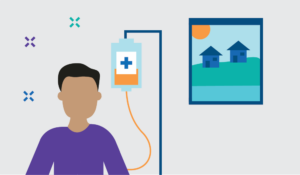Models of Care Toolkit
Community-based chemotherapy
 Community oncology clinics provide high quality care to patients in their local community. Receiving regular care close to home can lessen the burden of the disease while improving resource utilization and reducing healthcare costs both for patients and the system.
Community oncology clinics provide high quality care to patients in their local community. Receiving regular care close to home can lessen the burden of the disease while improving resource utilization and reducing healthcare costs both for patients and the system.
These models rely on a team of physicians, nurses, pharmacists, social workers and other staff who have specialized training in cancer services. In the model, the patient’s treatment is monitored by their family physician and cancer specialist to assess changes in their status and adjust care plans if needed.
Virtual chemotherapy supervision for rural patients
 Both oral-based chemotherapy and some IV chemotherapy administration are amenable to virtual care. IV chemotherapy regimens can be administered in rural hospitals by generalist doctors and nurses under the virtual supervision of a medical oncologist and nurses trained in chemotherapy.
Both oral-based chemotherapy and some IV chemotherapy administration are amenable to virtual care. IV chemotherapy regimens can be administered in rural hospitals by generalist doctors and nurses under the virtual supervision of a medical oncologist and nurses trained in chemotherapy.
Providing virtual chemotherapy supervision in rural areas provides patient care closer to home, enhances inter-professional communication, and expands scopes of practice for general practitioners in oncology. Ensuring adequate training for rural providers, coordinating between urban and rural sites and between health care providers and documenting clinical encounters are critical to optimize this model.
Through British Columbia’s Community Oncology Network, nurses, family physicians and pharmacists are trained to administer and manage cytotoxic and hazardous products and to conduct clinical diagnostic assessments and monitor patient care. They can also respond to therapy complications and provide 24-hour support for symptom management and toxicity.
This model offers an opportunity to deliver low-risk treatments close to home for common cancers. This enhances access to care in rural and remote communities and can shift the provision of routine cancer care to community-based clinics. The approach ensures that community-based clinics have appropriately trained and competent staff who are able to manage the delivery and monitoring of cytotoxic drugs, access to clinical diagnostic services and the capability to respond to complications 24-hours a day.
LloydsPharmacy Healthcare Centre is located in a community-based pharmacy in Lincolnshire, England. It provides breast cancer treatment, including nurse-administered treatment and a four-chair infusion centre, delivering a variety of treatments for patients. Pharmacists are available to provide advice to patients. The service allows patients in a rural county to receive care closer to home and has freed up 400 hours of infusion time in hospitals.
- Williamson S, Beaver K, Gardner A, Martin-Hirsch P. Telephone follow-up after treatment for endometrial cancer: A qualitative study of patients’ and clinical nurse specialists’ experiences in the ENDCAT trial. Eur J Oncol Nurs. 2018;34:61-67.
- Beaver K, Williamson S, Sutton CJ, Gardner A, Martin-Hirsch P. Endometrial cancer patients’ preferences for follow-up after treatment: A cross-sectional survey. Eur J Oncol Nurs. 2020;45(101722):101722..
- Beaver K, Williamson S, Sutton C, et al. Comparing hospital and telephone follow-up for patients treated for stage-I endometrial cancer (ENDCAT trial): a randomised, multicentre, non-inferiority trial. BJOG. 2017;124(1):150-160.
- Cohen PA, Webb PM, King M, et al. Getting the MOST out of follow-up: a randomized controlled trial comparing 3 monthly nurse led follow-up via telehealth, including monitoring CA125 and patient reported outcomes using the MOST (Measure of Ovarian Symptoms and Treatment concerns) with routine clinic based or telehealth follow-up, after completion of first line chemotherapy in patients with epithelial ovarian cancer. Int J Gynecol Cancer. Published online 2021:ijgc-2021-002999.
- Schenker Y, Althouse AD, Rosenzweig M, et al. Effect of an oncology nurse-led primary palliative care intervention on patients with advanced cancer: The CONNECT cluster randomized clinical trial: The CONNECT cluster randomized clinical trial. JAMA Intern Med. 2021;181(11):1451-1460.
- Komatsu H, Yagasaki K, Yamaguchi T, et al. Effects of a nurse-led medication self-management programme in women with oral treatments for metastatic breast cancer: A mixed-method randomised controlled trial. Eur J Oncol Nurs. 2020;47(101780):101780.
- Nelson S, Turnbull J, Bainbridge L, et al. Optimizing Scopes of Practice: New Models for a New Health Care System.; 2014. Accessed November 22, 2021. https://www.cahs-acss.ca/wp-content/uploads/2014/08/Optimizing-Scopes-of-Practice_REPORT-English.pdf
